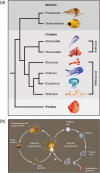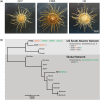Induction of Gametogenesis in the Cnidarian Endosymbiosis Model Aiptasia sp
- PMID: 26498008
- PMCID: PMC4620495
- DOI: 10.1038/srep15677
Induction of Gametogenesis in the Cnidarian Endosymbiosis Model Aiptasia sp
Abstract
Endosymbiosis is widespread among cnidarians and is of high ecological relevance. The tropical sea anemone Aiptasia sp. is a laboratory model system for endosymbiosis between reef-building corals and photosynthetic dinoflagellate algae of the genus Symbiodinium. Here we identify the key environmental cues to induce reproducible spawning in Aiptasia under controlled laboratory conditions. We find that simulating a lunar cycle with blue-wavelength light is necessary to promote abundant gamete production and synchronous release in well-fed animals. Sexual reproduction rates are genetically determined and differ among clonal lines under similar conditions. We also find the inverse difference in rates of asexual reproduction. This study provides the requisite basis for further development of the Aiptasia model system, allowing analysis of basic cellular and molecular mechanisms in the laboratory as well as investigations of broad questions of ecological and evolutionary relevance.
Figures




References
-
- Darling J. A. et al. Rising starlet: the starlet sea anemone, Nematostella vectensis. Bioessays 27, 211–221 (2005). - PubMed
-
- Genikhovich G. & Technau U. The starlet sea anemone Nematostella vectensis: an anthozoan model organism for studies in comparative genomics and functional evolutionary developmental biology. Cold Spring Harb. Protoc. 2009 9, (2009). - PubMed
-
- Holstein T. W., Hobmayer E. & Technau U. Cnidarians: an evolutionarily conserved model system for regeneration? Dev. Dynam. 226, 257–267 (2003). - PubMed
-
- David C. N. & Murphy S. Characterization of interstitial stem cells in Hydra by cloning. Dev. Biol. 58, 372–383 (1977). - PubMed
Publication types
MeSH terms
LinkOut - more resources
Full Text Sources
Other Literature Sources

